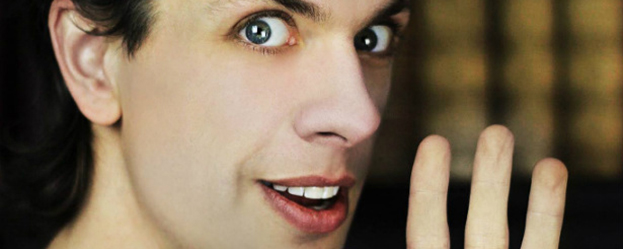This website uses cookies so that we can provide you with the best user experience possible. Cookie information is stored in your browser and performs functions such as recognising you when you return to our website and helping our team to understand which sections of the website you find most interesting and useful.
ED2015 Columns ED2015 Theatre ED2015 Week1 Edition
John Hinton: Why threes are (scientifically) magic
By John Hinton | Published on Wednesday 5 August 2015

We like the number three. For obvious reasons. Though let’s not forget, three is also the magic number. Do you know who also likes threes? Writer-performer John Hinton, who gives some thought to the rule of three right here, as he completes his award-winning musical ‘Scientrilogy’ at this year’s Fringe.
What’s your favourite number? Mine’s three. It’s definitely one of the prettiest-shaped numbers. And when you say it, it sounds so…free.
And it appears all over the place! An insect will keep three legs on the floor when it walks. Triangles are the strongest architectural shape (which is also why the pelvis is – roughly – triangular). There are trinities in almost all religions, modern and ancient. The building blocks of matter – protons and neutrons – are made of three quarks. Most startlingly, perhaps, we perceive space in exactly three dimensions. 3s, it s33ms, ar3 3v3rywh3r3.
Films work pretty well in threes too – the ‘Star Wars’, ‘Godfather’ and ‘Lord Of The Rings’ trilogies being obvious examples. When ‘Star Wars’ became six films instead, it lost its lustre. Soon there will be nine ‘Star Wars’ films – a trilogy of trilogies – and with any luck the magic of threes will be back at work. I’m crossing three fingers.
There are “rules of three” in many diverse fields: computer programming, economics, witchcraft, and there are loads of rules of three in theatre. Aristotle was the first to identify, 2500 years ago, that plays are made of three parts – a beginning, a middle and an end. Japanese Noh theatre goes further, with its concept of Jo-Ha-Kyu – even the beginning has a beginning, middle and end, as does the beginning of the beginning, and so on, down to every individual beat of the performance. Theatre is made of lots of threes.
Comedy writers are particularly familiar with the Rule Of Three. Jokes work best in three parts – a set-up, a development, and a twist. The “Englishman, Scotsman and Irishman” style of joke is perhaps the most obvious example. Fairy tales are also rammed with threes – Three Pigs, Three Brothers, Three Bears… Three, it seems, is “just right”.
And then, of course, we have fringe festivals. Just look at the title of this very publication! ThreeWeeks. Not one week, not four weeks. Three. Why should this be? When we put on plays at secondary school, we’d usually do three public performances, and there was an unwritten law that the first show would be enthusiastic but inept, the second would be competent but complacent, and that by the third show we’d finally get it right. Perhaps there’s a similar logic to Fringe Festivals being three weeks long – by week three, you’d hope that the piece has swung both ways and is achieved its potential.
So why am I personally so obsessed by the number? Well, because I’ve recently bowed to the pressure and am mining the magic. What began as a one-off musical comedy about Charles Darwin, which did very well at the Edinburgh Fringe in 2009, and then became two shows (the second being a musical comedy about Albert Einstein, which again did very well in Edinburgh 2013), has inevitably become a trilogy.
The scientist I’ve chosen this time is Marie Curie. She very neatly completes the tripartite division of the sciences – biology (Darwin), physics (Einstein) and chemistry (Curie). She became famous for her work on radioactivity. And how many types of radioactivity are there? Go on, have a guess.
For the three weeks of this year’s Edinburgh Fringe, Tangram shall for the first time be presenting all three “Scientrilogy” shows alongside each other. And we’ll just have to see whether three is indeed the magic number.
John Hinton’s three shows ‘The Origin of Species…’, ‘Albert Einstein: Relativitively Speaking’ and ‘The Element In The Room…’ were all performed at Pleasance Courtyard at Edinburgh Festival 2015.
LINKS: tangramtheatre.co.uk






